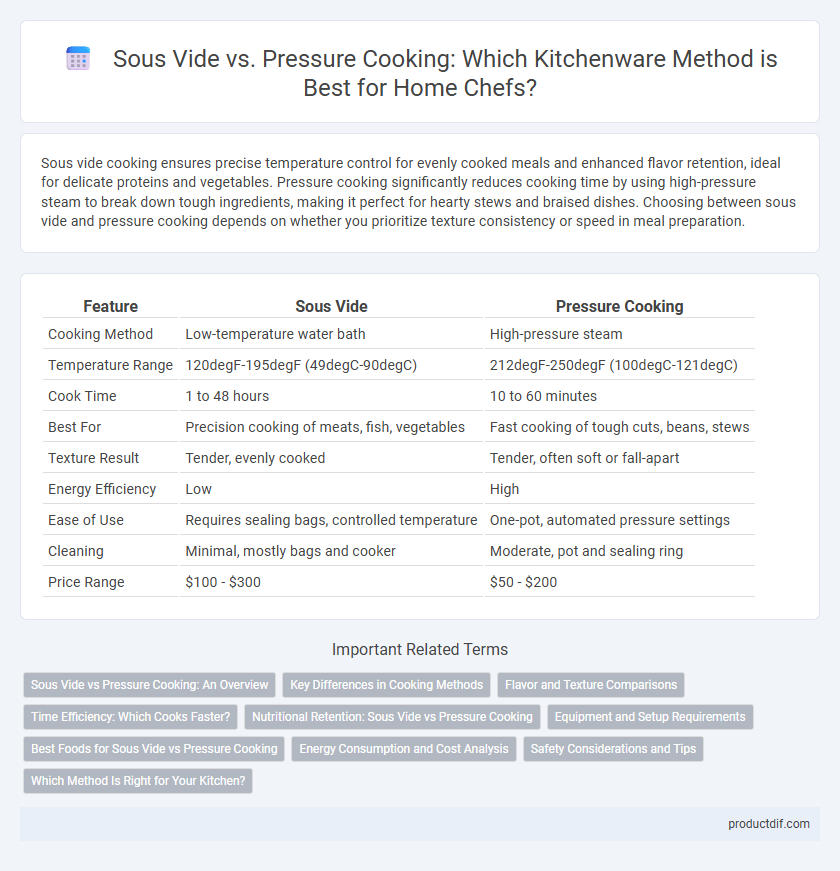Sous vide cooking ensures precise temperature control for evenly cooked meals and enhanced flavor retention, ideal for delicate proteins and vegetables. Pressure cooking significantly reduces cooking time by using high-pressure steam to break down tough ingredients, making it perfect for hearty stews and braised dishes. Choosing between sous vide and pressure cooking depends on whether you prioritize texture consistency or speed in meal preparation.
Table of Comparison
| Feature | Sous Vide | Pressure Cooking |
|---|---|---|
| Cooking Method | Low-temperature water bath | High-pressure steam |
| Temperature Range | 120degF-195degF (49degC-90degC) | 212degF-250degF (100degC-121degC) |
| Cook Time | 1 to 48 hours | 10 to 60 minutes |
| Best For | Precision cooking of meats, fish, vegetables | Fast cooking of tough cuts, beans, stews |
| Texture Result | Tender, evenly cooked | Tender, often soft or fall-apart |
| Energy Efficiency | Low | High |
| Ease of Use | Requires sealing bags, controlled temperature | One-pot, automated pressure settings |
| Cleaning | Minimal, mostly bags and cooker | Moderate, pot and sealing ring |
| Price Range | $100 - $300 | $50 - $200 |
Sous Vide vs Pressure Cooking: An Overview
Sous vide offers precise temperature control by cooking food in vacuum-sealed bags immersed in water, resulting in even doneness and enhanced flavor retention. Pressure cooking utilizes high-pressure steam to rapidly cook meals, drastically reducing cooking time while preserving nutrients. Both methods provide unique benefits depending on desired texture, speed, and culinary technique preferences.
Key Differences in Cooking Methods
Sous vide cooking involves sealing food in vacuum bags and cooking it at precise, low temperatures in a water bath for extended periods, ensuring even doneness and moisture retention. Pressure cooking uses high-pressure steam in a sealed pot to cook food quickly, significantly reducing cooking times while preserving flavors and nutrients. The key difference lies in sous vide's slow, controlled temperature method versus pressure cooking's rapid, high-pressure approach.
Flavor and Texture Comparisons
Sous vide cooking ensures precise temperature control, allowing proteins to retain natural juices and develop tender, evenly cooked textures with enhanced flavor infusion from marinades and spices. Pressure cooking uses high heat and steam to rapidly break down fibers, resulting in bold, rich flavors and soft textures, but can sometimes overcook or compress delicate ingredients. Both methods enhance taste uniquely: sous vide excels in subtle flavor retention and texture consistency, while pressure cooking produces robust, deeply developed flavors with faster cooking times.
Time Efficiency: Which Cooks Faster?
Pressure cooking typically cooks food faster than sous vide, with many dishes ready in under an hour compared to sous vide's slower, precise cooking process that can take several hours. Sous vide requires extended cooking times to ensure even temperature penetration, ideal for tenderizing meats and developing flavors gradually. Pressure cookers use high steam pressure to rapidly increase temperature and reduce cooking time, making them more time-efficient for busy kitchens.
Nutritional Retention: Sous Vide vs Pressure Cooking
Sous vide cooking preserves nutrients by gently cooking food at precise low temperatures, minimizing nutrient loss and maintaining vitamins and minerals. Pressure cooking uses high heat and steam, which can cause some degradation of heat-sensitive nutrients but often retains more nutrients compared to boiling or frying. Studies show sous vide can better retain water-soluble vitamins like vitamin C and B-complex, while pressure cooking excels at breaking down tough fibers, enhancing nutrient bioavailability.
Equipment and Setup Requirements
Sous vide cooking requires precise temperature-controlled water baths and vacuum sealers to ensure even cooking and moisture retention. Pressure cooking demands a sealed, insulated pot capable of maintaining high-pressure steam, typically with built-in safety valves and locking lids. Sous vide setups often involve more specialized equipment and longer preparation times, while pressure cookers offer more compact, faster cooking solutions with simpler hardware.
Best Foods for Sous Vide vs Pressure Cooking
Sous vide excels at cooking delicate proteins like salmon, steak, and chicken breast to precise temperatures, preserving moisture and texture. Pressure cooking suits tougher cuts of meat, beans, and root vegetables by breaking down fibers quickly for tender results. Both methods enhance flavor and texture but target different food types for optimal cooking outcomes.
Energy Consumption and Cost Analysis
Sous vide cooking typically uses lower temperatures over extended periods, resulting in moderate energy consumption compared to pressure cooking, which operates at higher temperatures and pressures for shorter durations, leading to higher instantaneous energy use but often lower total energy per meal. Pressure cookers can reduce cooking time by up to 70%, significantly decreasing overall energy costs despite their higher power draw. Evaluating cost efficiency, sous vide appliances generally have a lower upfront cost but may incur higher electricity expenses in long-term use, while pressure cookers offer faster cooking and energy savings ideal for frequent meal preparation.
Safety Considerations and Tips
Sous vide cooking minimizes the risk of bacterial contamination by cooking food at precisely controlled low temperatures over extended periods, ensuring even pasteurization. Pressure cooking achieves safety through high-temperature steam under sealed conditions, rapidly killing harmful pathogens but requires proper sealing and pressure release to prevent accidents. Always inspect sealing rings and valves for wear on pressure cookers, and use vacuum-sealed bags designed for sous vide to avoid contamination and equipment damage.
Which Method Is Right for Your Kitchen?
Sous vide offers precise temperature control ideal for retaining moisture and enhancing flavors, making it perfect for delicate proteins and long, slow cooking. Pressure cooking excels in speed and efficiency, rapidly tenderizing tough cuts and locking in nutrients with high pressure steam. Choosing between sous vide and pressure cooking depends on your meal preparation style, time constraints, and desired texture--precision and flavor boost versus quick, convenient cooking.
Sous Vide vs Pressure Cooking Infographic

 productdif.com
productdif.com